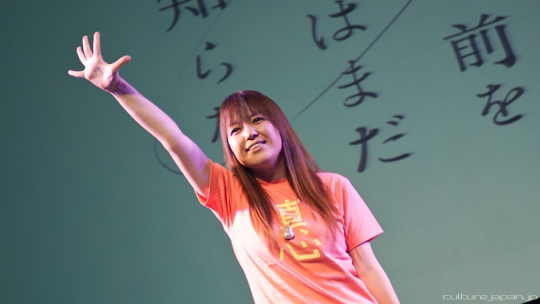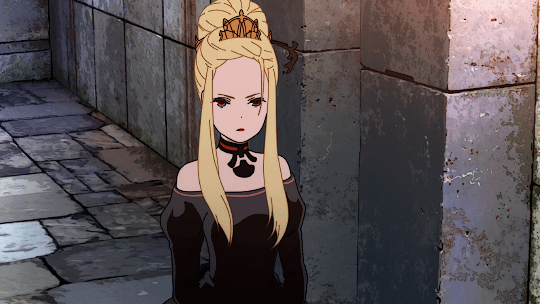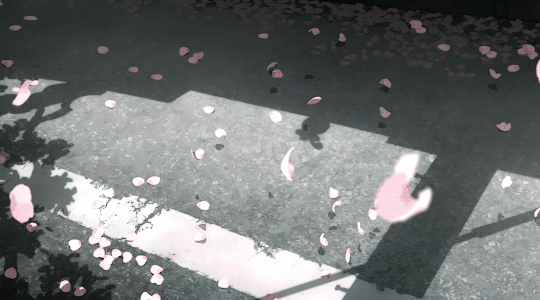originally posted at https://canmom.tumblr.com/post/668860...
Hiii friends! I’ve recovered from yesterday’s Japanese bakery/Taiko no Tatsujin exploits - more America Observations on that in a bit - and it’s time for Animation ‘Night’. Unfortunately being on California time means we’re slipping a lot compared to ‘7pm UK time’ - please forgive me! I slept like a log last night but still woke up late!!
Tonight we’re going to be visiting the work of Mari Okada, who is one of the most prolific screenwriters in anime and, in 2018, made a very striking step into direction with Maquia: When The Promised Flower Blooms. I’m gonna post a picture of her bc omg look at this dramatic pose. Maquia caught my eye thanks to a recommendation by animator Dong Chang, but digging in, it’s surrounded by some pretty interesting stories!

Maquia is notable for being a major turn in the history of PA Works towards cultivating younger animators, as kVin documented at the time with a couple of excellent articles on Sakugablog. This came two years in the wake of an unfortunate controversy about the studio in which an inbetweener talked about shit pay and bizarre treatment like charging inbetweeners a desk fee if they failed to graduate to key animation in a few years. As kVin pointed out, despite all that PA Works is unfortunately still better than average by the miserable standards of the anime industry.
Since then, it seems like - as far as this disconnected outsider can discern - they started making a genuine effort to sort some of this shit out, with the production of Maquia representing the fruit of several new initiatives to push the studio towards the KyoAni model: salaried positions for animators and an explicit training program led by veteran animator Toshiyuki Inoue. Some of the fruits of that training program were made available publicly in English - see here for Inoue’s notes on walk cycles, and on PA works site are some fantastically useful examples of animation of fire and walking which I’ve definitely found very useful. In addition to instructing these younger animators, Inoue provided a truly astonishing amount of key animation for the film itself:
Personal bonds dating back to the days where P.A. Works staff would cooperate with Production I.G bring him to the studio to animate special scenes every now and then, but this time around he truly outdid himself. Inoue drew 120 cuts of fully finished key animation, as well as 180 cuts of roughs that were by any sane standards virtually perfect already. On top of that, he drew the layouts for 100 other cuts for Takeshi Honda to finish. About 400 cuts total, meaning way more than your average episode of anime’s worth of nothing but master class work. The thorough consideration that went into every single gesture, as well as the volumetric dragon animation that looks like it shouldn’t be possible without CG support, left everyone in the team speechless. Yes, even Mari Okada!
and alongside him they brought on a long list of other veterans:
Tadashi Hiramatsu was first contacted to draw storyboards and supervise the animation, but his grasp on this medium as a whole is so firm that extra duties kept getting piled on him, to the point that they had to come up with the role of Core Director to explain just how integral he was to this movie from a technical standpoint. His presence was also an incentive for illustrious acquaintances like Akemi Hayashi to show up to draw beautiful sequences, which only further encouraged other ace animators to show up as well; Takeshi Honda, Hidetsugu Ito, Takaaki Yamashita, Akira Honma, Masahiro Sato, Kazuki Hoshino – the final list of key animators is adorned by many of the names we’ve come to expect from anime’s greatest productions.

What of director Mari Okada herself? Luckily she has published an autobio, parts of which are summarised by Anime News Network, so we can find out a lot about her. Her childhood was characterised by severe bullying, parental abuse and social anxiety that caused her to drop out in middle school; she made it back in on the strength of her writing but continued to struggle. She got some escape after moving to Tokyo to study game writing. But after graduating, she could only find various low-paying writing jobs.
Okada’s start in anime came back in 1998 with largely forgotten Sunrise sci-fi DT Eightron [wiki]:
Through her studies, Okada developed a passion for screenwriting, but found it difficult due to anxieties. Her earliest jobs included creating scenarios for direct-to-video pornography and transcribing interviews for a magazine. It was through this latter job that she met Tetsurō Amino, who asked her to contribute some of her ideas for the plot of DT Eightron. She went on to write the script for five episodes, and the connection with Amino helped in kickstarting her career.
Shortly after this, she sent Amino a story for an original anime project called The World Outside, based on a childhood experience of being threatened by her mother’s boyfriend. Though this never got made, writing it was a cathartic moment for her and informed a lot of her later work.
She continued to take a huge list of anime jobs, slowly climbing from the screenwriting position to the more senior role of ‘series composition’, i.e. a senior scriptwriter whose job is to help the director plan out the overall arc and major events of the series. ANN write:
Okada is a rare exception among anime screenwriters. Through her various original projects, she has been able to express many deep and personal emotions, something that not many scriptwriters have the freedom to do.
This does not mean that she’s had creative control over all the works she’s participated in lately. For example, with Mobile Suit Gundam: Iron-Blooded Orphans, director Nagai came up with most of the core ideas, and Okada only became involved with the project a few years after planning for the anime began. (She notes herself that this is the opposite of what her role was like on anohana and The Anthem of the Heart.) Within the industry, she’s valued not just for her original stories but for her ability to polish the ideas of her colleagues.

Her rise to fame began with her work on Hana-Saku Iroha, where she revisited The World Outside and chose to write a character based on her mother:
For Okada personally, one of the most important series she handled was Hana-Saku Iroha, where she was assigned a high degree of creative freedom. As she tried to think of ideas, she reread “The World Outside” for the first time in years. By then, Okada was in her thirties, and at last she felt that she could understand her mother’s feelings.
So she decided to write her mother into Hana-Saku Iroha.
In the anime, Ohana’s mother is a selfish and irresponsible woman. But Okada was sympathetic toward her, understanding that her own mother wished she could have been a free spirit yet felt constrained by her responsibilities.
Inevitably, writing an anime about her mother did little to reconnect them:
The success of Hana-Saku Iroha propelled Okada into fame almost seemingly overnight. But it didn’t mend her relationship with her mother, who was always indifferent about Okada’s work. When her mother watched Hana-Saku Iroha, she never saw herself in Ohana’s mother at all. The only thing she said about the character to Okada was, “That mother is a mess.” She had missed the point entirely.
But it did do a lot for Okada’s own career, and she became an in-demand screenwriter with the opportunity to write some more personal works.

This brings us to Anohana: The Flower We Saw That Day (あの日見た花の名前を僕達はまだ知らない We Still Don’t Know the Name of the Flower We Saw That Day) and The Anthem of the Heart (心が叫びたがってるんだ The Heart Wants To Shout) - both animated at A-1 Pictures.
Anohana is perhaps the most significant for Okada herself, directly based on her experience of self-isolation in childhood. The process of writing it sounds rather harrowing, after the animators decided to base it even more closely on her life:
Some aspects of the production, however, were a bit too confronting for comfort, especially when the production team decided to base the background art on Okada’s hometown [Chichibu] and even use her house as reference. Okada’s objections only caused arguments and delays in the production, and so she eventually gave in and allowed anohana to be set in Chichibu.

Nevertheless, the project led to overwhelming support from fans in Chichibu, and she returned to create another anime set there. Unfortunately her attempt to find an equal collabration with Nagai led to friction - yet it worked out in the end:
Okada and Nagai couldn’t agree on anything, and Okada would constantly backtrack on her ideas. As it turned out, the production flowed more smoothly when she focused on writing the scenario in her own style.
Okada thought that she had written the story with some emotional distance, but after seeing the film animated, she began to cry. Her situation was completely different from the heroine’s, but she saw her own emotions represented in the musical scene, when the characters finally allow their true feelings to be heard. She had tried to suppress her own writer’s voice in order to allow room for the director, but she had wanted to let her heart shout all along. After watching the film, she realized that.
“I had agonized so much over that project, but in the end it saved me.”
Anthem is notable also for its excellent character animation, conveying all sorts of subtleties of body language as Disgaeamad writes about here. A lot of this can be credited to the skill of key animator Masayoshi Tanaka, who’s known for his work with the later films of Makoto Shinkai (Animation Night 44).
By this point her star had risen to the point that PA Works president Kenji Horikawa proposed a ‘100% Okada anime’, a project that ultimately led to Maquia. Like many of Okada’s works, it’s About Motherhood. kVin writes:
It sings the praises of mothers and their strength with the same unflinching voice that tells us of the visceral pains of motherhood. It humanizes the cast with some of the most evocative character animation that this industry has to offer, and it still has the energy to spare to depict spectacular action and an appropriately dense world. Maquia is thematically tight tale – for the most part – that’s brought to life through one of the most astonishing production efforts that anime’s ever mustered.

Of course, taking on all the responsibilities of a director is a big jump for even a successful screenwriter; Okada was supported by the experience of assistant director Toshia Shinohara.
So after all this about its production, what is this anime actually about? Maquia turns away from the realistic character drama in modern settings that characterised most of Okada’s previous work, and instead goes for a fantasy world. The eponymous Maquia is a member of a species of immortals called the Iorph who flee genocide at the hands of a neighbouring kingdom. Fleeing the attack, Maquia picks up a child from a destroyed caravan; the film follows the life of Maquia and her adopted son in a variety of locations as she tries to reach the other Iorph diaspora whose immortality is still sought by the royal family. At least that’s the gist I get from the plot summary.
Also there’s loads of dragons involved!
I’m pretty hype to see this film, both for the beautiful character animation and the suitably emotionally wrenching story. For our other slot… As much as I would like to see Ano Hana, the series is too long for Animation Night, and the movie probably won’t fit in the time we have, so we’ll be giving that to Anthem of the Heart.
Animation Night 81 will be starting very shortly at twitch.tv/canmom - hope to see you there!
Comments